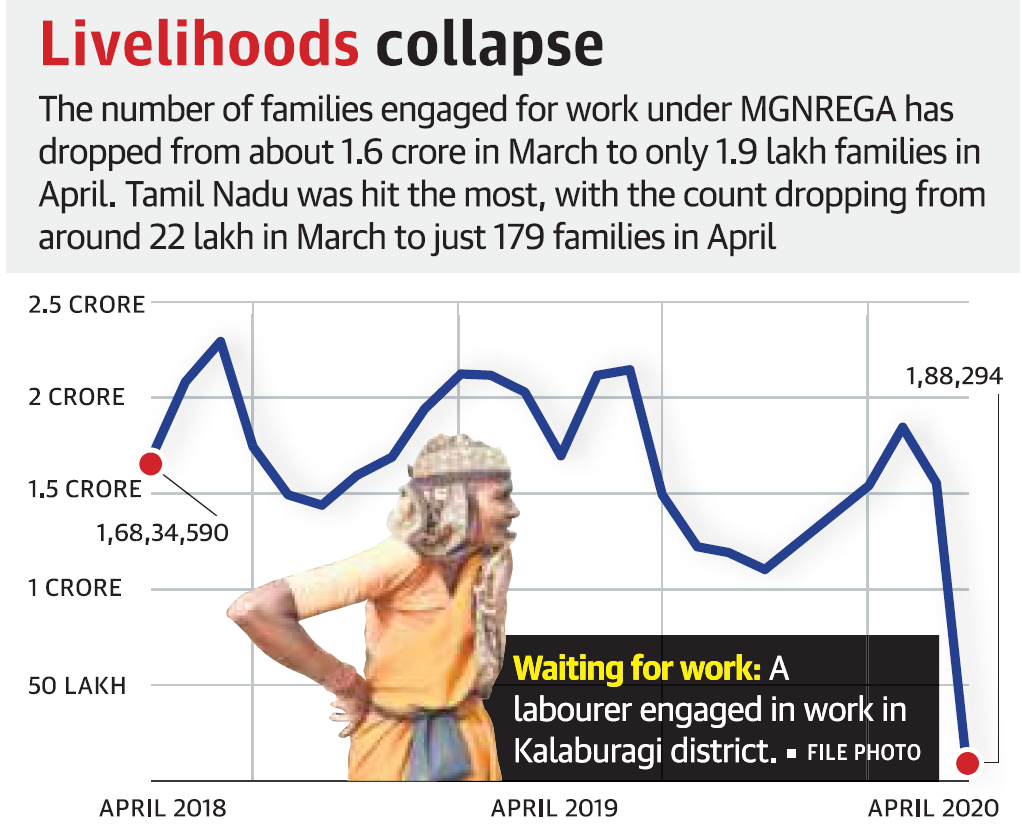Why in news?
Employment under the Mahatma Gandhi National Rural Employment Guarantee Act (MGNREGA) has collapsed to just over 1% of the usual rate in April, due to the COVID-19 lockdown.

How many are affected?
- Data from the MGNREGA website show that less than 1.9 lakh families have been provided work under the scheme so far in April 2020, in comparison to almost 1.6 crore households which were provided work in March, and the 1.8 crore households employed under the scheme in February before the lockdown began.
- The scheme, which guarantees 100 days of work per year at an average daily wage of ₹209, is key to providing livelihoods to poor villagers and is a backbone of the rural economy in difficult times.
- Overall, 7.6 crore families hold active job cards under the scheme, and almost 5.5 crore families found work under the scheme last year.
- The crash in employment rates under the scheme is despite the fact that migrant workers returning to villages should have increased demand in rural areas.
MGNREGA
- Mahatma Gandhi National Rural Employment Guarantee Act, MGNREGA, is an Indian labour law and social security measure that aims to guarantee the ‘right to work’. This act was passed in September 2005.
- It aims to enhance livelihood security in rural areas by providing at least 100 days of wage employment in a financial year to every household whose adult members volunteer to do unskilled manual work.
- It covers all districts of India except the ones with 100% urban population.
- MGNREGA is to be implemented mainly by gram panchayats (GPs). The involvement of contractors is banned.
- Apart from providing economic security and creating rural assets, NREGA can help in protecting the environment, empowering rural women, reducing rural-urban migration and fostering social equity, among others.
How MGNREGA came to be?
In 1991, the P.V Narashima Rao government proposed a pilot scheme for generating employment in rural areas with the following goals:
- Employment Generation for agricultural labour during the lean season.
- Infrastructure Development
- Enhanced Food Security
This scheme was called the Employment Assurance Scheme which later evolved into the MGNREGA after the merger with the Food for Work Programme in the early 2000s.
Features of MGNREGA
- It gives a significant amount of control to the Gram Panchayats for managing public works, strengthening Panchayati Raj Institutions.
- Gram Sabhas are free to accept or reject recommendations from Intermediate and District Panchayats.
- It incorporates accountability in its operational guidelines and ensures compliance and transparency at all levels.
Objectives of MGNREGA
- Provide 100 days of guaranteed wage employment to rural unskilled labour
- Increase economic security
- Decrease migration of labour from rural to urban areas





